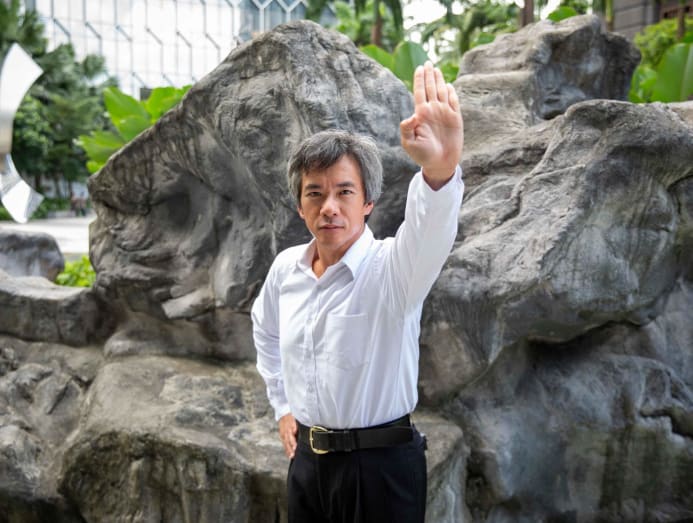The Stories Behind: The traffic officer who dances like a 'smooth criminal' to keep traffic moving
SINGAPORE — When I met Mr Devon Woon in the central business district, he was dressed in a well-ironed shirt and formal pants — just like any worker in the area.
It was hard to picture him as the same traffic officer known to bust out smooth dance moves while controlling vehicles at intersections.
But within minutes of our meeting, there was no doubt he was the same man captured on videos that have gone viral.
He jumps up and readily demonstrates a pop and lock, spin and kick — all moves that are part of the artistic repertoire he adopts while on the job.
A fan of Michael Jackson since primary school, the 41-year-old traffic officer’s moves are a mashup of standard traffic management hand gestures and dramatic flicks of his wrist and legs, all done while pulsating to a beat.
His short demonstration at our meeting was enough to catch the eye of those around us, so it is no surprise that his full repertoire is often caught on video by curious drivers and pedestrians.
One TikTok video of him spinning at a junction outside Waterway Point in June last year with his pop and lock movements has generated over 200,000 views and close to 8,000 likes.
His moves have also been caught on video at high-traffic events like Formula One.
Mr Woon said it was not his intention to go viral online and has not seen the clips of him at work on Instagram or TikTok as he does not have accounts of his own.
But he has been told by friends and his ex-students from his teaching days that they have seen such videos.
“It’s something that motivates me to excel further, when I'm doing more and I find that the responses are getting better…they say thumbs up, very good job what you’re doing. The heightened sense of appreciation will then motivate me to perform better, to do more,” he said.
NOT JUST FOR LAUGHS
Prior to becoming a traffic controller, Mr Woon was a physical education (PE) teacher and a martial arts coordinator — jobs that also brought out the “performer” in him.
In fact, he also displayed his martial arts talents as a contestant on Asia’s Got Talent in 2015.
Although he did not pass the audition stage with his martial arts display, Mr Woon said he had "no regrets" as the experience was meaningful and he tried his best.
He recalled receiving a standing ovation from one of the judges after delivering a short speech where he explained that he was a teacher and hoped his participation in the contest would encourage his students to not be afraid to pursue their passions.
“To me, even traffic control is a form of performance. If you look at it, it can be a dance. It can be made with robotic pop and lock movements,” said Mr Woon, who started this job around two years ago.
He dances out of a desire to “(bring) laughter back to the roads” and “(bring) comedy back to life while fulfilling the goal of ensuring zero accidents.
“I like to put a smile on their faces. It helps a lot because when you brighten someone's day, you alleviate tension on the road, then you get less road rage. With less people who are impatient on the roads and are aggressive, people tend to give way more.”
Asked if he thought his moves might distract drivers or prompt a chiding from his bosses, Mr Woon said that he has always “acted professionally” and focused on being a “safety buffer” while bringing a “magical touch and artistic spin” to his work.
Given that passers-by often stop by to give him and his colleagues drinks as thanks, he’s confident his style of conducting his job is well-received.

Beyond providing entertainment, Mr Woon said adding flair to traffic direction is a practical adaptation to on-road conditions as every movement has “purpose and intent”.
“I have a lot of ways to communicate with drivers. I use body language. I don't just use the conventional hand signs. Of course the best is to use professional Traffic Police hand signs, just the basics, but even then (drivers) don't understand. A lot of drivers don’t know, because (those signs) are too formal,” he said.
He even carries a set of yellow and red cards, typically used by referees in football matches.
At a jammed up box junction, Mr Woon flashes a yellow card as a comedic “first warning” to drivers who obstruct traffic.
“First warning, I give to you. You want to move or not? Don’t want to move, I take out my second yellow card…then I take out my red card. Of course drivers also understand I’m joking, trying to be comical. So they play along and respond (by making a face) to say, ‘Oh, very sad leh’,” said Mr Woon.
As traffic officers cannot take enforcement actions against traffic offenders unlike the police, Mr Woon said taking a more comedic approach to encourage motorists to be considerate is generally well-received and road users are more likely to cooperate.
While the job demands keeping a cool head under pressure, Mr Woon said that it is when traffic is the busiest, that he is most inspired to dance as his moves come up in the “spur of the moment”.
“When I'm on the roads and I start busting out some movements, there is no music playing in my head, but what I am actually trying to do is to fine tune myself and be in sync with the traffic flow,” said Mr Woon.
As the rough surface on the road and his steel toe boots make it difficult to successfully replicate the dance move’s smooth glide, Mr Woon uses robotic movements to do a “failed” moonwalk that amuses motorists while indicating where they should drive towards him.
When both of his hands are signing “stop” to a group of drivers, his background in martial arts comes in handy as he kicks his leg backwards to indicate to other drivers that they can start moving.
TOOK UP JOB TO SURVIVE DURING COVID-19 BUT NOW SEES IT AS A CALLING
Yet even as his performances lighten the moods of many motorists and netizens, it is clear that Mr Woon takes his job seriously.
As a traffic controller, he has to work under the hot sun and in gruelling conditions, for shifts as long as 12 hours, with one hour breaks to eat and go to the bathroom.
On the back of one such shift, Mr Woon tells me that it was a particular “siong” (fierce in Mandarin) day, as he was under the hot afternoon sun which was later overtaken by sudden rain.
“We’re always in danger standing where we are and sometimes motorists don't comply or are confused due to road closures,” he said, adding thankfully he or his colleagues have not been in an accident so far.
While standing amidst traffic no matter the weather may not suit many, the physically demanding nature of the role is what attracted Mr Woon to the role.
“You have to be up on your feet all the time. You have to be fit, you have to react fast. You have to be able to be assertive and firm and lead with confidence and competence. If you issue a stop order and the vehicle keeps inching forward, you have to move back fast and react,” he said.
After leaving his PE teacher job, Mr Woon found difficulty finding a job during the Covid-19 pandemic. Since then, taking up the role of traffic officer on a freelance basis has been about “survival”.
Since job assignments for traffic officers like Mr. Woon are primarily based on daily-rated contracts tied to specific construction sites or road diversions, he finds himself working at various locations.
He typically receives less than a day's notice about where he will be deployed, and jobs are posted and quickly snapped up by other officers over WhatsApp groups.
Though some may look down on blue collar work for drawing a relatively lower pay, Mr Woon said he is unphased by the stigma.
While he continues to look for full time employment in a mentorship role, Mr Woon said he is happy to play a part in “breathing life into the roads”.
“You’re not just guarding property and securing the worksite, you're also managing lives on the roads. You need to take care of safety for everyone, you're kind of the safety buffer between motorists, pedestrians and the client contractors working on the ground doing the roadworks.
“For me, it’s really a responsibility, not a job. It’s a strong cause I believe in. It’s not a paycheck, it’s a calling and purpose.”









